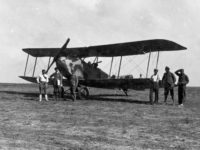The AEG C.IV formed the most important aircraft of the C Group, as in this model for the first time a synchronized machine gun was installed for the pilot, with which both the observer and the pilot could perform attacks and repel. In addition, this variant served as a template for later aircraft.
Development and construction:
In the construction of the C.IV the engineers oriented themselves on the C.II model. Although a quite effective prototype was developed with the C.III, hardly any technical innovations were adopted from it.
The C.IV version was slightly larger than the C.II. The decisive innovation, however, was the machine gun synchronized with the engine, which allowed the pilot to also carry out attacks. This not only fought enemy fighters, but also ground targets.
The C.IV was thus the standard aircraft of the AEG C series. Although other versions were then built, but they all remained in the prototype status and were not further produced.
In addition to the successor models emerged from the C.IV series also a version for a night bomber under the name AEG C.IV.N. This prototype was developed in 1917 and had a stronger engine and a wider span. However, this model did not reach beyond the status of the prototype.
The situation was different with the ground attack aircraft AEG J.I, which was developed from the C.IV version. This aircraft, which was specially developed to combat ground targets, was produced in large numbers.
Use in the First World War:
The AEG C.IV aircraft quickly replaced the two previous variants at the front after the launch. Due to the high number of over 400 aircraft, these formed the backbone of the German Enlightenment until the end of the war.
Technical specifications:
| Designation: | AEG C.IV |
| Country: | German Empire |
| Typ: | Armed reconnaissance aircraft |
| Length: | 7,18 meters |
| Span: | 13,45 meters |
| Height: | 3,35 meters |
| Mass: | 800kg empty |
| Crew: | Max. 2 |
| Engine: | Mercedes D III engine with 119 kW (160 PS) |
| Maximum speed: | 158 km/h |
| Reach: | unknown |
| Armament: | a 7,92 mm forward facing 08/15 machine gun and a 7,92 mm Parabellum machine gun |
You can find the right literature here:
Fokker Dr I Aces of World War 1 (Aircraft of the Aces)
Undoubtedly the most famous fighter type to see service on either side during World War 1, the Fokker Dr I was a revelation when it entered service on the western front in 1917. Manfred von Richthofens JG 1 circus was the first Jasta to completely re-equip with the new fighter, and in the skilled hands of its numerous aces the Dr I proved a formidable opponent. The Dr I remained in service on the Western Front until replaced by the superior Fokker D VII in May 1918. Just weeks prior to that, however, Germanys leading ace, the great Red Baron, had been killed at the controls of a Dr I.
Friedrichshafen Aircraft of WWI: A Centennial Perspective on Great War Airplanes (Great War Aviation) (Volume 21)

Friedrichshafen Aircraft of WWI: A Centennial Perspective on Great War Airplanes (Great War Aviation) (Volume 21) Paperback – February 16, 2016
This book describes and illustrates the development of Friedrichshafen aircraft of WWI with text, 540 photos, 18 in color, 37 color profiles, production quantities and serial numbers of aircraft, and aircraft dimensions and performance specifications. In addition, there are 26 official SVK drawings and 11 aircraft are illustrated in scale drawings to 1/48 (4) or 1/72 (7) scales. The book has 312 pages and is of interest to aviation historians, enthusiasts, and modelers alike.
German and Austro-Hungarian Aircraft Manufacturers 1908-1918
Much has been written about the British aircraft of the First World War, but little has surfaced about the aircraft of the Axis powers, Germany and Austria. Here, Terry C. Treadwell tells the story of the aircraft from companies such as Fokker, builder of the famous triplane, as fl own by Baron von Richthofen's Flying Circus, AEG, Albatros, Junkers and Hansa. From reconnaissance aircraft to state-of-the-art bombers that could reach London, this is the definitive guide to aircraft of the Axis powers during the First World War. The aircraft are explained in detail and a history of each company is provided, making this an excellent source book for aircraft enthusiasts, model makers and those interested in the air war over the trenches of France and Belgium, as well as further afield in the Italian campaign.
The Zeppelin in Combat: A History of the German Naval Airship Division
The standard reference now revised and expanded. Dr. Robinson has opened up his vast photo archives to enhance this new edition of his classic work. Much of the new photographic material is published here for the first time.
This post is also available in:
 Deutsch (German)
Deutsch (German)  Français (French)
Français (French)  Italiano (Italian)
Italiano (Italian)  简体中文 (Chinese (Simplified))
简体中文 (Chinese (Simplified))  Русский (Russian)
Русский (Russian)  Español (Spanish)
Español (Spanish)  العربية (Arabic)
العربية (Arabic)

















